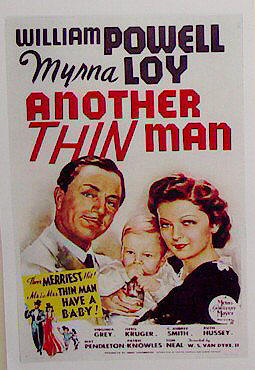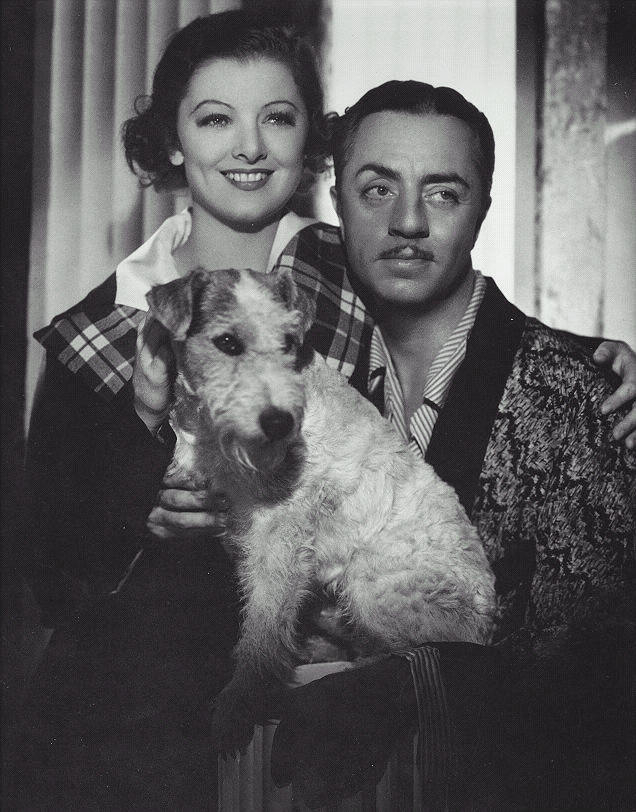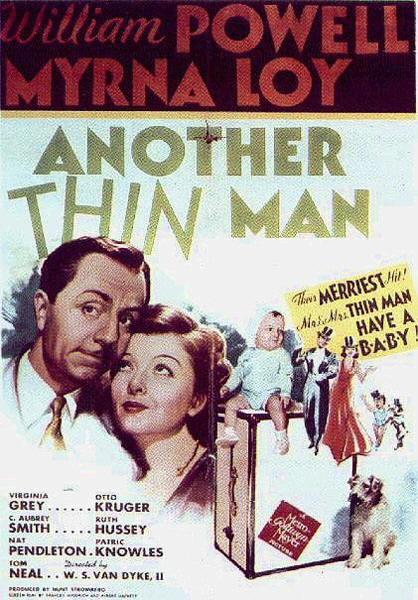Needless to say that with the success of After The Thin Man, MGM was anxious for a third film. All plans were put on hold though, while William Powell and the studio went through some contract re-negotiations.
Meanwhile, in February 1937, Hammett sold MGM all rights to The Thin Man characters, with the exception of radio rights, for the sum of $40,000. Old Gold Cigarettes were courting Hammett with the prospect of bringing Nick and Nora to radio. Hammett would have to do nothing at all for the series except cash the $500 per episode check they wanted to pay for the rights. Although he was given on-air credit for the scripts, Hammett refused to even meet with the script writers or producers for the show. It was the same deal Hammett had for The Adventures of Sam Spade and The Fat Man.
The radio show was finally produced in July, 1941. It starred Lester Damon as Nick, Claudia Morgan as Nora and Parker Fennelly as their friend Ebenezer Williams, Sheriff of Crabtree County. Over the series’ run, Les Tremayne, Joseph Curtin and David Gothard would also play Nick. The show would continue until its cancellation in the wake of Hammett’s run in with the US Circuit Court.
The film version of The Thin Man was adapted for the hour-long series Lux Radio Theater on CBS on June 6th, 1936, with Powell and Loy reprising their roles. This was to be the series’ first show to originate from Hollywood and for CBS. (It previously ran on NBC.) After The Thin Man received the same treatment on Lux on June 17, 1940 with Powell and Loy returning to the microphones.
 By late March 1937, MGM had settled their contractual differences with Powell and were anxious to start on the next Thin Man picture. They were less than enthused about dealing with Hammett’s unreliable working habits, however. Instead of giving him a weekly salary, they wished to negotiate a separate contract for him to produce a story treatment. Claiming bookkeeping problems, MGM withheld payment on The Thin Man rights purchase in an effort to pressure him into the deal. It evidently worked, as Hammett, with hotel bills mounting, signed the contract on April 13th. The deal called for MGM to pay Hammett $5,000 for the story synopsis, an additional $10,000 on acceptance of the synopsis and a final $20,000 for a complete screen story.
By late March 1937, MGM had settled their contractual differences with Powell and were anxious to start on the next Thin Man picture. They were less than enthused about dealing with Hammett’s unreliable working habits, however. Instead of giving him a weekly salary, they wished to negotiate a separate contract for him to produce a story treatment. Claiming bookkeeping problems, MGM withheld payment on The Thin Man rights purchase in an effort to pressure him into the deal. It evidently worked, as Hammett, with hotel bills mounting, signed the contract on April 13th. The deal called for MGM to pay Hammett $5,000 for the story synopsis, an additional $10,000 on acceptance of the synopsis and a final $20,000 for a complete screen story.
Hammett returned to Hollywood and again took up his residence at the Beverly Wilshire, this time in a suite once occupied by the visiting King of Siam. He finished the synopsis by July and began work on the extended treatment with the Hacketts.
Unfortunately, his old bad habits quickly resurfaced. Through the fall of `37, Hammett continued to drink and missed several story conferences. He wrote letters to Lillian Hellman, who was in Russia attending the Moscow Theater Festival, saying that he didn’t want to write anymore, but just stay drunk. His only joys in life seemed to be gambling at a local racetrack and listening to George Gershwin concerts on the radio.
In one letter to Hellman, dated December 26, 1937, a dispirited Hammett told her that the movie he was writing was a “charming fable of how Nick loved Nora and Nora loved Nick and everything was just one big laugh in the midst of other people’s trials and tribulations…”
In reality, the final treatment finished by Hammett and the Hacketts on May 13, 1938, was part original story material with portions of an old Hammett Continental Op story, “The Farewell Murder” (Black Mask, February, 1930) mixed in. The one hundred and forty page outline, which included two versions of one eighteen page segment, was entitled Another Thin Man. The title referred to Nick and Nora’s son, Nicky, Jr. and how he would grow up to be just like his father. The title also reinforced the perception of Nick Charles being the titular Thin Man and not the murdered Wynant of the first film.
 Powell was not thrilled with the prospect of having a screen son. As he told Loy, “First thing you know, he’ll be in kindergarten, then prep school, then college. How old will that make us?”
Powell was not thrilled with the prospect of having a screen son. As he told Loy, “First thing you know, he’ll be in kindergarten, then prep school, then college. How old will that make us?”
If Powell was unenthused about having his cinematic offspring, the Hacketts were even more so. As Albert told a reporter for the Providence (R.I.) Journal, “We thought the second Thin Man picture would be the last when we hinted they were going to have a baby . . . but the reviews [said] there must be a third picture planned, because they were going to have a baby. We just made it doubly hard on ourselves.”
MGM approved the outline in the early summer, but wanted some revisions. Hammett’s health was failing again but he was in no financial position to refuse. He had gambled all his money away at the track. He owned the Wilshire six months back rent, his limo service was threatening to sue for non-payment of his bills and his liquor tab at a local pharmacy was in excess of $1,300.
Nevertheless, he worked on the revisions through 1938, writing three more drafts of the story before the Hacketts began work on the screenplay. However, as work progressed, he became more uncooperative, failing to keep appointments with the Hacketts and communicating with Stromberg only through telegram.
Another Thin Man opens with the Charles arriving in New York City. Nick and Nora are summoned out to the Long Island Estate of Colonel MacFay, Nora’s father’s former business partner who is now in charge of Nora’s business affairs. On the way there, Nick spots a body on the side of the road, but when he stops the car to investigate, it has disappeared.
At MacFay’s, Nick and Nora meet Lois, MacFay’s adopted daughter, her fiancée Dudley Horn and Freddie, MacFay’s secretary. Everyone is in a state of nervousness. Over dinner MacFay tells Nick and Nora that he is being threatened by a former employee, Phil Church. Church had been in charge of handling various shady dealings for MacFay and had gone to jail as a result. MacFay says that Church has stated that he has twice dreamt of MacFay being murdered and when he dreams of something three times, it comes true. Dinner is interrupted by a commotion- someone has set the pool’s bath house on fire and killed Lois’ dog.
 Nick decides to go talk to Church. He discovers that Church’s home is being watched by a thick spectacled man who claims to be with the police but is actually racketeer “Diamond Back” Vogel. At Church’s, Nick meets Dum-Dum, the roadside “murder victim.” Church says that he is leaving for Cuba that evening. He also hints that Nick should mind his own business. He hasn’t started dreaming about Nora and Nicky, Jr.- “Yet.”
Nick decides to go talk to Church. He discovers that Church’s home is being watched by a thick spectacled man who claims to be with the police but is actually racketeer “Diamond Back” Vogel. At Church’s, Nick meets Dum-Dum, the roadside “murder victim.” Church says that he is leaving for Cuba that evening. He also hints that Nick should mind his own business. He hasn’t started dreaming about Nora and Nicky, Jr.- “Yet.”
That night, MacFay is stabbed. The police are summoned but in the confusion Dorothy Waters, Nick, Jr.’s nanny, slips out. While the police question everyone, Asta discovers the murder weapon outside. When Nick goes to retrieve it, he is shot at by Horn. The police return fire, killing him.
Nick identifies the knife as one he had seen in Dum-Dum’s possession at Church’s. The police figure that Horn was trying to frame Church, but Nick states that their theory wouldn’t explain why Horn would shoot at him. As the Charleses head back to Manhattan, Nick feels that there are two mysteries to be solved- Who killed Colonel MacFay and why did Dudley Horn shoot at him?
The performances are generally good through out the picture, though Ruth Hussey’s scenes as Nicky, Jr.’s nurse in the beginning of the film tend to broadcast her character’s role in the finale. Nat Pendleton returns to the series to reprise his Thin Man role of Lt. Guild. Marjorie Main (of the Ma and Pa Kettle series) stands out in her one scene as the gregarious landlady Mrs. Dolley. The dancers in the West Indies Club, Rene y Estela, were real headliners at New York’s Havana-Madrid Club.
Sharp-eyed viewers of may spot Doodles Weaver (of Spike Jones and his City Slickers) in an uncredited role as the gatekeeper at MacFay’s estate and a similarly uncredited Stooge Shemp Howard as the shady Wacky who shows up in the film’s final third.
Filming began in July 1939 and ran through August. Myrna Loy was just returning from a European vacation while an anxious William Powell was just getting back to work for the first time after a two year fight with cancer. Perhaps discouraged over his slow recovery from the second of his two operations, Powell remarked to his friend Quentin Reynolds “By the time I’m ready for Another Thin Man, Myrna and I will be too old to play anything but character parts.”
It was Powell’s first film at MGM in nearly two years. He had last been on the lot completing Double Wedding when fiancée Jean Harlow had died unexpectedly of uremic poisoning on June 7, 1937. While he was recovering from that, he had been diagnosed with cancer. The nature of his illness had been kept quite and not many of the crew and cast had seen much of him in the intervening time. They only knew that he had spent the last year or so battling a serious illness.
Even with doctors clearing Powell for work, Van Dyke was more than willing to make concessions for his star. As he told Powell-
For openers, your shooting schedule will be strictly ten to four, and that’s official. I won’t let you work any more than that even if you want to. You just learn your words and show up on time and leave the rest to me!
 Van Dyke also saw to it that the production was allocated four sound stages and a double than normal size crew to facilitate speedier setups. All the principals had stand-ins for lighting. Powell was given a limo for shuttling between the soundstages and his own portable dressing room had an oversized couch with extra pillows and blankets for between scene napping.
Van Dyke also saw to it that the production was allocated four sound stages and a double than normal size crew to facilitate speedier setups. All the principals had stand-ins for lighting. Powell was given a limo for shuttling between the soundstages and his own portable dressing room had an oversized couch with extra pillows and blankets for between scene napping.
When Powell finally appeared on set for the first day of shooting, he was greeted by a rousing round of cheers and applause from the crew. At a loss for a witty remark, he received a hug and a kiss from Loy. By the time filming had finished, many friends felt that the William Powell of old was back.
The filming was not without its problems. Stromberg had been prescribed morphine by an unscrupulous doctor for a back injury. As his addiction to it increased so did the disorganization in his production unit. Despite any problems, the cast crew only needed to reunite for one day’s worth of retakes, shot on October 13. The unit also traveled to the town of Chico in Butte County in northern California for the exteriors of the Bidwell Mansion.
Another Thin Man was released on November 17, 1939 and once again the reviews were good. Frank Nugent wrote in the New York Times wrote, “This third of the trademarked Thin Men takes its murders as jauntily as ever, confirming our impression that matrimony need not be too serious a business and provides as light an entertainment as an holiday amusement seeker is likely to find.”
Despite the reviews and the studio’s wish to continue the series, this would be the last Thin Man film to have both Hammett’s and the Hackett’s participation. On December 7, 1938, Hammett submitted an eight-page outline for a fourth film, tentatively titled “Sequel to the Thin Man.” (Evidently written very quickly after completing his work on the script for Another Thin Man.) The story featured a host of returning characters from the first two films.
In the outline, Macaulay, the murderous lawyer from the first film, has escaped from prison, vowing to kill Mimi. Mimi and son Gilbert move to San Francisco, but are followed by Macaulay, who is masquerading in drag. They go to Mimi’s first husband Chris, who is back with his first wife Georgia. Georgia is seeing Morelli behind Chris’s back. Chris and Dancer, the nightclub owner from After the Thin Man, plan on extorting money from Mimi.
After a “battle royale” at Nick and Nora’s between Morelli, Dancer, Georgia, Chris and Mimi, Chris is murdered on the way to his hotel. In his haste to leave the scene, Macauly drops his wig and is arrested for murder. Nick isn’t convinced of Macauly’s guilt and begins to investigate. He ultimately proves that it was Gilbert who shot Chris, convinced that the money Mimi was paying in extortion was rightfully his, as his father’s heir.
The entire plot bordered on the ridiculous and some of Hammett’s biographers have speculated if the whole thing wasn’t done to test Stromberg’s patience.
The outline was rejected on Christmas Day, 1938. By early spring of 1939, Hammett was back to work adapting a 1929 Continental Op story called “Fly Paper” into the original, non-Thin Man screen story Girl Hunt. On July 14, Hammett’s contract was cancelled and Girl Hunt was returned to his agent, rejected on August 12, 1939.
The Hacketts also had no desire to continue working on the series. As Frances later told Myrna Loy, “Finally, I just threw up on my typewriter. I couldn’t do it again; I couldn’t write another one.”





